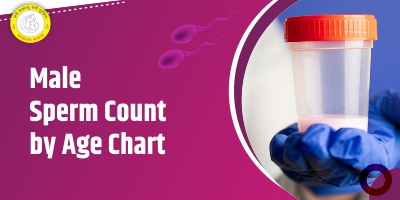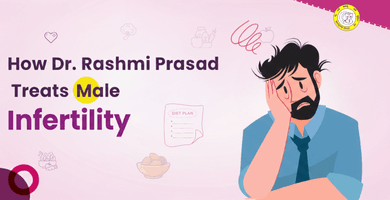Male Sperm Count by Age Chart: How Age Affects Fertility

Most people talk about a woman’s biological clock, but here’s something you don’t hear as much—men have one too. Sure, it ticks a little slower, but it’s definitely there. Sperm health doesn’t stay the same forever, and if you’re planning to start a family someday, it’s important to understand how things change over time.
In this Article
The Male Sperm Count by Age Chart helps you understand these changes clearly. In this blog, we’ll explain what to expect at different ages and share simple tips to keep your fertility in check.
At Diwya Vatsalya Mamta IVF, Dr. Rashmi Prasad and our expert team offer personalized care to help improve sperm health and support your journey to parenthood.
Why Male Sperm Count Matters in Fertility
A doctor will check sperm count early on in a male fertility assessment. Having more sperm makes it more likely that an egg will get fertilized. Besides the number, how well and how normally the sperm move and look matters for conception.
If a man has low sperm count, also called oligospermia, it can be more difficult to conceive. When there is a severe problem, the sperm count drops to zero which may cause male infertility. Therefore, it’s smart to watch your sperm health from the start.
What Is a Normal Male Sperm Count?
Firstly, a healthy sperm count is vital; according to the World Health Organization (WHO). A normal sperm count range, according to the World Health Organization (WHO), is at least 15 million sperm per milliliter of semen. Anything below this may affect fertility. But remember—sperm count isn’t everything.
Here’s what a complete semen analysis usually checks:
- Volume: Amount of semen in one ejaculation.
- Sperm count: Total number of sperm in a given sample.
- Motility: How well the sperm move.
- Morphology: How many have a normal shape.
If you’re concerned about fertility, these results together give a better picture than sperm count alone.
How Does Age Impact Male Fertility?
By referring to the Male Sperm Count by Age Chart, men can better understand the gradual decline in sperm health as they age. At around age 40, men frequently notice that their testosterone has decreased, their sperm swim more slowly and there is more damage to their sperm DNA.
Although there aren’t sudden changes in male fertility, it can take longer to get pregnant and pregnancy may bring slightly greater risks. Male fertility by age can be a true problem for couples struggling to conceive after age 35.
Male Sperm Count by Age Chart
Here’s a quick look at how sperm count typically changes over time. These are general averages, and individual numbers may vary:
| Age Range | Average Sperm Count (million/mL) |
| 20–29 | 60–100 |
| 30–39 | 50–70 |
| 40–49 | 40–60 |
| 50–59 | 30–50 |
| 60+ | 20–40 |
This Male Sperm Count by Age Chart gives a good idea of the slow, steady decline. It’s not meant to scare you—just to help you be aware and take action early if needed.
How to Interpret Your Sperm Count Test Results
Getting a sperm count test is simple. After giving a semen sample, labs measure a few key areas:
- Sperm count per mL
- Total sperm count in the sample
- Motility (percentage of moving sperm)
- Morphology (how many are normally shaped)
If your results fall below the normal sperm count range, it doesn’t mean you can’t have children. It just means you may need further evaluation or changes in lifestyle or treatment. Sometimes, repeating the test after a few weeks is recommended, since factors like stress or illness can temporarily affect results.
If you want to learn more about infections and their impact on sperm health, check out our detailed guide on pus cells in sperm.
Lifestyle Factors That Affect Sperm Count
There’s good news: many low sperm count causes are linked to lifestyle—and you can do something about them.
Here are a few things that can affect sperm health and lifestyle:
- Smoking and alcohol: Both lower sperm quality.
- Poor diet: Deficiency in vitamins like zinc, vitamin C, and folate impacts sperm production.
- Lack of exercise or too much of it: Balance is key.
- High stress levels: Chronic stress interferes with hormones.
- Heat exposure: Hot tubs, laptops on your lap, or tight underwear can reduce sperm temporarily.
If you want to improve sperm count naturally, focus on balanced nutrition and include these 12 powerful foods in your diet, exercise, managing stress, and avoiding excessive heat.
Medical Treatments and Interventions for Low Sperm Count
If lifestyle changes aren’t enough, medical options are available:
- Hormone therapy: To fix hormonal imbalances.
- Medications: Like clomiphene or HCG injections to boost sperm production.
- Surgery: To correct blockages or conditions like varicoceles (swollen veins in the testicles).
- Assisted reproductive technology (ART): IVF or ICSI can help couples conceive even with very low sperm count.
Important Note: Before starting any treatment, it’s essential to consult a specialist. Every person’s fertility journey is unique, and expert guidance from IVF Specialist, Dr. Rashmi Prasad can make all the difference.
Conclusion
The Male Sperm Count by Age Chart gives a clear picture of how fertility shifts over time. While men don’t have a sharp fertility drop like women do, sperm count, and quality do decline slowly with age. Understanding male infertility factors early on, making healthy lifestyle choices, and checking your sperm count can really help. It’s important to get advice from a doctor to find the right treatment for you.
At Diwya Vatsalya Mamta IVF, Dr. Rashmi Prasad and her experienced team provide personalized care and advanced treatments to support. If you are seeking male infertility treatment in Patna, feel free to contact us. We’re here to help you on your journey to parenthood.
FAQs
What is a normal sperm count for men by age?
A normal sperm count is at least 15 million per milliliter at any age, but younger men (20s and 30s) tend to have higher average counts—often between 60 to 100 million/mL.
How does age affect sperm motility and morphology?
With age, sperm move more slowly (reduced motility) and are more likely to be abnormally shaped (poor morphology), both of which can lower fertility.
What causes low sperm count in men?
Common low sperm count causes include hormonal issues, smoking, alcohol, stress, obesity, certain medications, and exposure to heat or environmental toxins.
Can lifestyle changes improve sperm count naturally?
Yes, eating well, exercising, avoiding smoking and alcohol, managing stress, and limiting heat exposure can all help improve sperm count naturally.
Does sperm quality decline with age?
Yes, sperm quality—including motility, morphology, and DNA integrity—gradually worsens with age, especially after 40.
What are the symptoms of low sperm count?
There are usually no obvious symptoms. Most men find out only when facing difficulty with conception. In some cases, hormonal problems may cause other signs like reduced facial hair or low sex drive.
Why choose Diwya Vatsalya Mamta IVF, the top IVF specialist hospital in Patna?
At Diwya Vatsalya Mamta IVF, led by renowned IVF Specialist Dr. Rashmi Prasad, we provide personalized fertility treatments with advanced technology and compassionate care. Find us Diwya Vatsalya Mamta IVF Hospital Patna on Google Maps.



